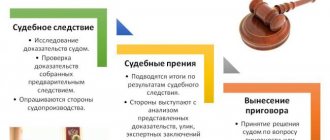Trial is the main stage of the civil process, in which the civil case is resolved on the merits by the court.
The trial is the main, central part of the stage of proceedings in the court of first instance, during which the tasks assigned to the courts are carried out to protect the rights, freedoms and legitimate interests of subjects of Russian law, strengthen law and order, prevent offenses, and form a respectful attitude towards the law and the court ( Article 2 of the Code of Civil Procedure of the Russian Federation).
The Civil Procedure Code of the Russian Federation establishes a strict procedure for the consideration and resolution of civil cases, in which the sequence of procedural actions is one of the conditions for issuing a lawful and justified court decision.
At the trial stage in full:
- the principles of civil procedural law are implemented;
- factual circumstances relevant to the case are established on the basis of a comprehensive and complete examination of the evidence;
- the rights and obligations, legitimate interests of interested parties are determined and a court decision is made in the name of the Russian Federation, which resolves the case on its merits.
Civil cases are considered and resolved by the court before the expiration of two months from the date of receipt of the application to the court, unless other terms for consideration and resolution of cases are established by the Code of Civil Procedure of the Russian Federation, and by the magistrate before the expiration of a month from the date of acceptance of the application for proceedings.
Cases regarding reinstatement at work and collection of alimony are considered and resolved before the end of the month.
The hearing of a civil case takes place in a court session with mandatory notification of the persons participating in the case about the time and place of the hearing.
The judge hearing the case alone performs the duties of the presiding judge. During a collegial hearing of a case in a district court, the judge or chairman of this court presides; in sessions of other courts, the judge, chairman or deputy chairman of the relevant court presides.
The presiding judge presides over the court hearing, creates conditions for a comprehensive and complete examination of the evidence and circumstances of the case, and eliminates from the trial everything that is not related to the case under consideration. If any of the participants in the process objects to the actions of the presiding officer, these objections are recorded in the minutes of the court session. The presiding officer gives explanations regarding his actions, and during a collegial consideration of the case, explanations are given by the entire composition of the court.
The presiding officer takes the necessary measures to ensure proper order at the court hearing. The orders of the presiding judge are binding on all participants in the process, as well as on citizens present in the courtroom.
When considering a case, the court is obliged to directly examine the evidence in the case: listen to explanations of the parties and third parties, testimony of witnesses, expert opinions, consultations and explanations of specialists, read written evidence, examine material evidence, listen to audio recordings and watch video recordings.
The hearing of the case takes place orally and with the same composition of judges. If one of the judges is replaced during the consideration of a case, the proceedings must be carried out from the very beginning.
The court hearing in each case takes place continuously, with the exception of the time appointed for rest. Until the end of the consideration of the initiated case or until the adjournment of its proceedings, the court has no right to consider other civil, criminal and administrative cases.
Preparatory part of the trial when considering a civil case
The preparatory part of the trial is a system of procedural actions aimed at determining the possibility of considering the case on its merits.
In particular, the court resolves the following issues: the possibility of hearing the case:
- given the composition of the court;
- in case of non-appearance of persons participating in the case, their representatives;
- hearing of the case in case of failure to appear of witnesses, experts, specialists, and translators summoned in the case.
The sequence of procedural actions in the preparatory part of the trial is regulated in Art. 160-171 Code of Civil Procedure of the Russian Federation.
Preparation
During this stage of the trial, the presiding judge announces the case that will be tried. After this the secretary speaks. He reports which of the invited persons is present, whether summonses were served on those who did not appear, as well as the reasons for non-presence. The presiding officer establishes the identities of those who appeared and checks the credentials of representatives and officials. An interpreter may also be involved in civil litigation. At the beginning of the examination, his duties and rights are explained to him. In case of failure to appear for an unexcused reason, the translator may be subject to administrative liability. Witnesses are removed from the courtroom before their interrogation begins.
Consideration of the case on the merits in civil proceedings
Consideration of the case on its merits is the central part of the court hearing. It is here that the circumstances of the case and the available evidence are examined in an adversarial manner.
The circumstances of the case are considered within the limits of the claims stated by the plaintiff, and only in cases provided for by federal law, the court has the right to go beyond these limits (Part 3 of Article 196 of the Code of Civil Procedure of the Russian Federation, Article 166 of the Civil Code of the Russian Federation, Article 24 of the RF IC, Article 394 of the Labor Code RF). The examination of evidence in a court hearing is carried out on the basis of the rules of relevance and admissibility (Articles 59, 60 of the Code of Civil Procedure of the Russian Federation) under the conditions of the principles of immediacy, orality and continuity (Article 157 of the Code of Civil Procedure of the Russian Federation).
The consideration of the case on its merits begins with a report by the presiding judge or one of the judges. The presiding judge then determines whether the plaintiff supports his claims, whether the defendant accepts the plaintiff’s demands, and whether the parties wish to conclude the case with a settlement agreement.
The plaintiff’s statement of abandonment of the claim, the defendant’s acknowledgment of the claim and the terms of the settlement agreement between the parties are entered into the minutes of the court session and signed by the plaintiff, the defendant or both parties. If the refusal of the claim, recognition of the claim or a settlement agreement of the parties is expressed in written statements addressed to the court, these statements are attached to the case, as indicated in the minutes of the court session.
If the court does not accept the plaintiff’s refusal of the claim, the defendant recognizes the claim, or does not approve the settlement agreement of the parties, the court issues a reasoned ruling on this and continues to consider the case on the merits, moving on to hearing explanations from the persons participating in the case.
After the report of the case, the court hears explanations from the plaintiff and the third party participating on his side, the defendant and the third party participating on his side, and then other persons participating in the case. The prosecutor, representatives of state bodies, local government bodies, organizations, citizens who have applied to the court for the protection of the rights and legitimate interests of other persons are the first to give explanations. Persons participating in the case have the right to ask each other questions. Judges have the right to ask questions to persons participating in the case at any time during their explanations.
Explanations in writing of persons participating in the case, in case of their failure to appear, as well as in cases provided for in Articles 62 and 64 of the Code of Civil Procedure of the Russian Federation, are announced by the presiding officer.
After hearing the explanations of the parties and other persons participating in the case, the court establishes the order of examination of the evidence and begins to consider it. Typically, the evidence presented by the plaintiff is considered first, and then the evidence presented by the defendant.
When all the available evidence in the case and all the essential circumstances of the case have been considered, the presiding officer asks the persons participating in the case and their representatives whether they would like to make additional explanations. In the absence of such a desire, the presiding judge declares the consideration of the case on the merits completed and proceeds to judicial debate.
Bankruptcy through the MFC - out-of-court bankruptcy
In 2021, debtors had the opportunity to declare themselves bankrupt not only through the court, but also in a simplified manner - without trial through the MFC. Extrajudicial bankruptcy is simpler and free.
A person can become bankrupt through the MFC:
- having a debt in the amount of all obligations of no more than 500,000 rubles;
- in respect of whom the enforcement proceedings are completed due to the lack of property.
The scheme of such bankruptcy differs from bankruptcy through the court. A person submits to the MFC only an application and a list of creditors. The MFC independently verifies the right to write off debts through the FSSP, then publishes a message about the start of an out-of-court procedure.
After 6 months, the MFC includes information about the completion of the procedure in the Unified Federal Register of Bankruptcy Information. The debtor is released from obligations to creditors, which he reported when submitting the application.
For clarity, here is a comparison table:
| Judicial bankruptcy | Extrajudicial bankruptcy | |
| Debt amount | From 300,000 ₽ | Up to 500,000 ₽ |
| Instance | Court | MFC |
| Price | From 80 thousand ₽ | For free |
| Decree to terminate the use. production | No need | Need to |
| Deadlines | From 6-13 months | 6 months |
Judicial debates when considering a civil case
Judicial debates consist of speeches by persons participating in the case and their representatives. In this part of the court session, the persons participating in the case present their own considerations regarding the assessment of evidence, give a legal assessment of the facts, justify their position on the case, and express an opinion on whether the stated requirement can be satisfied. Thus, the study of factual circumstances and evidence is summed up, which helps the court to fully and comprehensively consider the case.
The sequence of speech (Article 190 of the Code of Civil Procedure of the Russian Federation) is as follows: the plaintiff and his representative, the defendant and his representative.
Third parties who do not make independent claims act after the plaintiff or defendant (depending on whose side they are on).
Third parties making independent claims are heard after the parties and their representatives.
The prosecutor, representatives of state bodies, local government bodies, citizens who apply to protect the interests of other persons are the first to participate in the debate.
All participants in the debate have the right to make a second comment regarding what was said by other persons. The right of the last remark belongs to the defendant and his representative (Article 190 of the Code of Civil Procedure of the Russian Federation).
Participants in judicial debates do not have the right to refer to evidence that was not examined at the court hearing. If there is a need to clarify new circumstances that are important to the case, to examine new evidence, then the court, by its ruling, resumes the proceedings on the merits.
General information
A criminal trial may take place with the participation of a jury. The prosecutor acts as a mandatory participant in the consideration. The arbitration trial may take place with the participation of a panel or one official. People's representatives are invited to consider cases collegially. Civil litigation is usually conducted by one official. In almost all cases, except those provided for by law, the secretary is involved in the consideration. He takes the minutes. The presiding judge of the court plays a leading role in the meeting. He guides the course of the consideration, ensures an objective examination of the circumstances, excluding everything that is not related to the essence of the dispute.
Declaration of the decision and announcement of the decision in a civil case
The delivery of the decision is the last part of the court hearing. Here the final results of the trial are summed up, the civil case is decided on its merits.
The decision is made only in the deliberation room, where the judge hearing the case or the judges who are members of the court in the case may be present. The presence of other persons in the deliberation room is not permitted. Judges do not have the right to disclose information that became known to them in the deliberation room when making a decision. These rules guarantee the independence of judges and allow them to focus as much as possible on the merits of the case. Violation of the secrecy of a meeting of judges is an absolute basis for the cancellation of a decision (clause 8, part 2, article 364 of the Code of Civil Procedure of the Russian Federation).
When making a decision, the court must answer the following questions:
- what facts are important for the case and on the basis of what evidence should they be considered established;
- what facts relevant to the case have not been established;
- what are the legal relations of the parties;
- what rule of substantive law should be applied to the established facts;
- how the case should be resolved (whether the plaintiff’s demands can be satisfied and to what extent);
- how legal costs in the case should be distributed;
- whether the court decision is subject to immediate execution.
If the court finds it necessary to clarify new circumstances relevant to the case or examine new evidence, it issues a ruling to resume the trial.
Typically, the court makes a decision on the claims made by the plaintiff. However, in cases provided for by federal law, it may go beyond the stated requirements (Article 196 of the Code of Civil Procedure of the Russian Federation).
The court's decision is made by a majority vote. None of the judges has the right to abstain from voting. At the same time, each of them has the right to attach their own separate opinion to the matter. The dissenting opinion is included in the case, but is not made public.
After the decision is made and signed, the court returns to the courtroom, where the presiding judge or one of the judges announces the court's decision. Then the content of the decision, the procedure and deadline for appealing it are explained orally.
After this, the court session is declared closed.
The court's decision is announced publicly, except in cases where it runs counter to the rights and legitimate interests of citizens (for example, in adoption cases).
To persons participating in the case, but not present at the court hearing, copies of the court decision are sent no later than 5 days from the date of adoption of the court decision in final form.
Bankruptcy through the Arbitration Court
The opportunity for a citizen to declare himself bankrupt in court appeared in 2015, when changes to the Federal Law “On Insolvency (Bankruptcy)” came into force. From this moment on, not only a legal entity, but also an individual can become bankrupt. The procedure for declaring a citizen bankrupt is regulated by Chapter X of the Federal Law “On Insolvency (Bankruptcy)”, where the deadlines for each stage are also established.
To recognize a citizen as insolvent, the sequence of application of bankruptcy procedures has been determined.
To start the bankruptcy process, it is not necessary for a citizen to go to court. Bankruptcy of an individual can be initiated by a creditor or an authorized body. In practice, bankruptcy is a long and tedious legal process.
Bankruptcy procedure for individuals faces in 2021Related article
- The minimum period of the process according to the law is 6 months from the moment of initiation of the case until the relevant decision is made to declare the citizen bankrupt.
- The maximum period from the date of initiation of the case is not limited and can reach several years.
The overall term is influenced by many factors - the number of debts of a person, his general financial situation and circumstances complicating the case (such as searching for property and challenging transactions).
Pre-trial procedures
Before filing an application with the court, it is necessary to complete a number of pre-trial steps.
Stage 1: Finding a financial manager and lawyer
The financial manager is the person appointed by the court to conduct the proceedings. The responsibilities of such a specialist include:
- management of debtor accounts,
- identifying hidden accounts and fictitious contracts,
- receipt and distribution of the debtor's income,
- inventory and sale of property,
- management of issues related to bankruptcy.
The manager ensures that the legitimate interests of all participants in the process are observed. Without a financial manager, it is impossible to carry out bankruptcy proceedings for an individual.
You should not neglect the search for an experienced lawyer. A lawyer in court will help make bankruptcy profitable and minimize losses after declaring bankruptcy, shorten the procedure time, doing everything quickly and in a timely manner. The lawyer will organize the process and remove all unnecessary hassle from the debtor without bothering him again.
Stage 2: Collection of necessary documents
In order to file an application to declare a citizen bankrupt in court, it is necessary to collect a significant pile of documents. What documents must be attached to the application are established in Article 213.4 of Law No. 127.
Documents for bankruptcy of an individual in 2021Related article
Why are they attached to the application? To prove to the court:
- impossibility of fulfilling obligations to creditors;
- the need for bankruptcy and debt write-off.
The applicant submits copies of: passport, SNILS, INN, certificate of marriage or divorce, and the presence of children, information on income and withheld tax for 3 years, copies of transaction documents for three years, copies of loan agreements, certificates of debt, receipts, etc. Further. Here is the complete list:
List of documents for bankruptcy - 25.5 KB
The deadline for collecting some documents does not depend on the applicant. For example, when ordering a certificate from a bank or restoring lost documents from various authorities, a citizen loses time due to the sluggishness of authorities. Lawyers will prepare a complete package in 2 weeks, and this is included in the turnkey support.
Stage 3: Preparing and sending an application to the Arbitration Court
It is important to write and submit your insolvency application correctly. If the application is incorrect or filed in the wrong place, the court will return or leave the documents without movement. The deadline for accepting the application will be delayed, and banks and microfinance organizations will learn about your intentions and begin preparations.
You can submit an application with attachments to the court in the following ways:
- Send by mail - registered mail with a list of attachments;
- Submit online using the My Arbitr service;
- Submit it in person to the court office.
During the pandemic, access to court buildings is limited, so in 2021, personal submission of documents through the office is not possible in all regions.
Protocol of a court hearing in civil proceedings
During each court session of the court of first instance, as well as when each individual procedural action is performed outside the court session, a protocol is drawn up (Article 228 of the Code of Civil Procedure of the Russian Federation).
The protocol of a court session is a procedural written document certifying the completion (non-completion) by the participants of the process of all procedural actions that took place during the trial.
The minutes of a court session or a separate procedural action performed outside a court session must reflect all essential information about the proceedings of the case or the commission of a separate procedural action.
The minutes of the court session indicate:
- date and place of the court hearing;
- start and end times of the court hearing;
- the name of the court hearing the case, the composition of the court and the secretary of the court session;
- name of the case;
- information about the appearance of persons participating in the case, their representatives, witnesses, experts, specialists, translators;
- information on explanations to persons participating in the case, their representatives, witnesses, experts, specialists, translators of their procedural rights and obligations;
- orders of the presiding officer and rulings made by the court in the courtroom;
- statements, petitions and explanations of persons participating in the case, their representatives;
- testimony of witnesses, explanations by experts of their conclusions, consultations and explanations of specialists;
- information about the disclosure of written evidence, data from the inspection of material evidence, listening to audio recordings, viewing video recordings;
- the contents of the conclusions of the prosecutor and representatives of state bodies and local government bodies;
- content of court pleadings;
- information about the announcement and explanation of the content of the court decision and court rulings, an explanation of the procedure and deadline for appealing them;
- information on explaining to the persons participating in the case their rights to familiarize themselves with the protocol and submit comments on it;
- date of drawing up the protocol.
The protocol is drawn up at a court session or when a separate procedural action is performed outside the session by the secretary of the court session. To ensure the completeness of the protocol, the court may use shorthand, audio recording and other technical means.
The protocol indicates the use by the secretary of the court session of audio recording and other technical means to record the progress of the court session. The audio recording medium is attached to the minutes of the court session.
Persons participating in the case and their representatives have the right to petition for the disclosure of any part of the protocol, for the inclusion in the protocol of information about circumstances that they consider significant for the case.
The minutes of the court session must be drawn up and signed no later than three days after the end of the court session, the minutes of a separate procedural action - no later than the next day after the day of its commission.
The minutes of the court session are signed by the presiding officer and the secretary of the court session. All changes, additions, and corrections made to the protocol must be agreed upon and certified by the signatures of the presiding judge and the secretary of the court session.
Persons participating in the case and their representatives have the right to familiarize themselves with the protocol and, within five days from the date of its signing, submit written comments on the protocol indicating any inaccuracies and (or) incompleteness in it.
Introduction
The trial stage is one of the stages of civil proceedings where the direct administration of justice occurs. In other words, it represents the basis on which the entire mechanism of legal proceedings rests, since the further progress of the case depends only on the outcome of the trial: its review in the manner prescribed by law and (or) the execution of the judicial act passed on it.
The relevance of the research topic is determined by the fact that the procedure for legal proceedings in civil cases is regulated by the norms of civil procedural law and represents certain successive stages (stages). This division of the civil process is due to the fact that only with a clear, rational organization of the procedure for conducting legal proceedings is it possible to successfully implement the jurisdictional function of the state and protect the rights of subjects going to court.
The purpose of this work is a complete and comprehensive study of the issue of judicial proceedings in the Russian Federation.
The objectives of this study, in accordance with the stated goal, are: - consideration of the concept, meaning and stages of the stages of legal proceedings; - study of the procedure for hearing a case in the court of first instance.
The object of the study is social relations that develop in the process of consideration and resolution of civil cases.
The subject of the study is the norms of legislation of the Russian Federation at various levels, as well as the views of scientists on the issues under consideration.
When researching this work, the following general scientific methods were used: analysis, synthesis, induction, analogy, modeling, abstraction, generalization and systematization. The following special methods were also used: logical-legal, comparative-legal, historical-legal, system-structural, as well as formal-legal.
The work was used: the Constitution of the Russian Federation, other legal acts, works of such scientists and researchers of the issue under consideration S.Z. Zhenetl, R. A. Kurbanova, V. A. Gureev, O. N. Diordieva, E. T. Barbakadze, A. V. Chekmarev and others.
Procedure for considering comments on the protocol
Comments on the protocol are reviewed by the judge who signed it - the presiding judge at the court session, who, if he agrees with the comments, certifies their correctness, and if he disagrees with them, issues a reasoned ruling on their complete or partial rejection. The comments are included in the case in any case.
Comments on the protocol must be considered within five days from the date of their submission.
Based on the results of consideration of the comments, the judge is empowered to:
- certify the correctness of the comments in full;
- certify that some of the comments are correct;
- make a reasoned decision regarding their complete rejection;
- make a reasoned determination regarding their partial rejection.
Tags material evidence civil case evidence legislation comments on the protocol plaintiff settlement agreement circumstances of the case explanations of the parties defendant debate of the parties recognition of the claim principles protocol of the court session court decision secretary of the court session parties court session trial
About the consequences
Bankruptcy is a complex process. Having gone through all stages of insolvency in court, or by applying to the MFC for this purpose, the debtor receives bankrupt status and gets rid of debts. It sounds like a fairy tale - “get rid of debts once and for all.” But this is a legal way out of the debt trap, but which is not suitable for every debtor.
There will be consequences after bankruptcy. They are established by law:
- within 5 years, when receiving a credit or loan, the debtor is obliged to notify the future creditor of his bankruptcy status;
- for 3 years will not be able to manage a legal entity or hold leadership positions in budgetary organizations;
- within 5 years, a citizen will not be able to declare himself bankrupt again through the court;
- within 10 years, the debtor will not be able to re-declare bankruptcy out of court.
A competent lawyer will not advise everyone to immediately go bankrupt. This needs to be done wisely and with the right approach. We, having extensive experience in working with bankruptcy processes for individuals, know where to start and how to structure work with a client on the issue of bankruptcy in such a way as to minimize his losses and save him from unnecessary headaches.
Stage No. 1. Acceptance of a claim for proceedings
The court can accept a statement of claim only if there are all grounds for this provided by law. If the claim is filed in accordance with all the rules of jurisdiction, correctly filed, the full state fee is paid and all the necessary documents are attached to the claim, then the court will accept the claim for proceedings within five days from the date of its receipt.
If the claim does not comply with the requirements established by law, the judge may refuse to accept the claim, return it, or leave the claim without progress until the identified deficiencies are eliminated.
The phrase accepting a claim for proceedings translated into Russian means that the court will consider your case.
Leaving the claim without progress means that you have not provided the full evidence base for your case, or have not paid the state fee correctly, or have incorrectly formulated your requirements and the court is giving you time to correct the error.
This is important to know: Registration of returning goods to the supplier: list of documents in 2022, new rules








